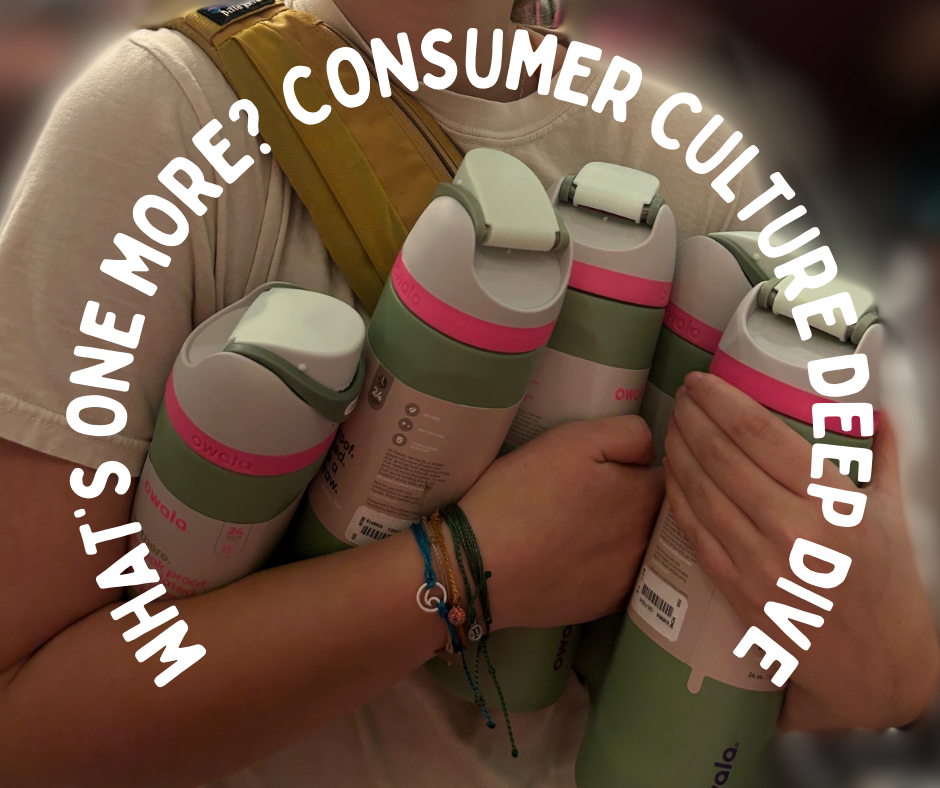Consumerism has been ingrained into American ideals for decades. With the turn of the century and the constant pressure of fighting climate change, many companies thought to help offset these issues by creating multi-use products to help reduce one’s carbon emissions. But where companies saw a solution, consumers saw new products hitting the shelves that they needed to attain.
What is consumerism and consumer culture?
According to the Merriam-Webster Dictionary, consumerism is, “The theory that an increasing consumption of goods is economically desirable [or] a preoccupation with and an inclination toward the buying of consumer goods.” Unlike consumerism, consumer culture has a more nuanced definition, but in broad terms, consumer culture can be described as the culture in which social status, values and activities are centered on the purchase and consumption of goods and services– or in shorter terms; you are what you buy.
When and why has this become a problem?
Overconsumption or mass consumerism began to ramp up after World War II. As America was pulled out of the Great Depression, the economy skyrocketed with the country’s further industrialization caused by the aftermath of the war and the country’s entrance into the Cold War. During this time, many household inventions, brands and forms of entertainment contributed to the start of America’s consumer culture.
Between the years 1970 to 2021, consumer spending has increased by over 400 percent. Inventions and innovations are in no way bad, but what led to this issue is how society tied one’s possession of materialistic goods to their identity and self-worth. Now in 2024, this issue is seen prominently with the rise of social media and trends. As influencers are used to promote and market products by companies, their followers are subjected to constant exposure to new trends and products that their influencers claim to be “obsessed” with. This then successfully influences viewers to buy whatever new trend or fab is being displayed in front of them.
Following trends lets viewers relate to their favorite celebrities and other netizens, leading to many partaking in buying whatever new brand is popular. Today the problem of overconsumption is a direct cause of this. For example, back in 2018 HydroFlasks were all the rage with the rise of popular social media trends such as “VSCO Girls”, then it moved onto Stanleys due to how many social media personalities were raving about the brand’s quality. Now the internet and its viewers are fascinated by Owalas– a “fun, new and innovative” water bottle that is not entirely all that innovative or any different from other bottles on the market.
Senior Sadie Fox has seen many fall victim to these trends. She said, “I think having multiple bottles defeats the purpose. Why does somebody need eight versions of the same bottle in different colors? Soon a new bottle will be trending and the cycle will repeat. There is no way this is good for the environment.”
Unlike Fox, some find that they have a genuine need for the items they are mass purchasing. Senior Vanessa Gonzalez is a proud owner of eight Owala bottles. She said, “I think I need them just in case something happens to one of them, but I also just like having a lot of them. Especially when new colors are released.”
Many brands claim to be sustainable in the sense that they are creating goods that are to be reused, but due to the rise of consumer culture the sustainability that brands are after no longer matters as consumers are purchasing multiples of each product and are always expectant of the availability of the said product.
Do companies even care anymore?
Many companies are known for their drive for sustainability, but because of mass consumption, many companies are now known for just making sustainable products, not being sustainable creators. A sustainable product is a product that can be used many times while being made of eco-friendly material. A sustainable company is a company that practices eco-friendly methods of sourcing and creating its products. Many companies due to consumer culture no longer fall between both categories. An example of such would be Stanley.
While Stanley is known for their “Built for Life” policy, their recent climb to fame has seen more of a negative impact on the environment than a positive one. According to the New York Times, in comparison to the creation of plastic bottles, stainless steel bottles emit 14 times more greenhouse gasses when created. The company’s lack of solution to the problems their product is creating showcases how at the end of the day they too fall victim to consumer culture and its materialistic benefits.
How can one reduce their part in this?
The answer is simple, stop buying and letting social media trends sway you. Think about the impact each item bought will have on the environment. Think about whether the item is a want or a need– and then proceed to buy more needs than wants. Science teacher Ms. Sara Brickley said, “I think it’s important for everyone to be aware that each individual does have an impact. No matter how big or small it is, being mindful is something that you can do, not only to just feel good about but also to help future generations.”


